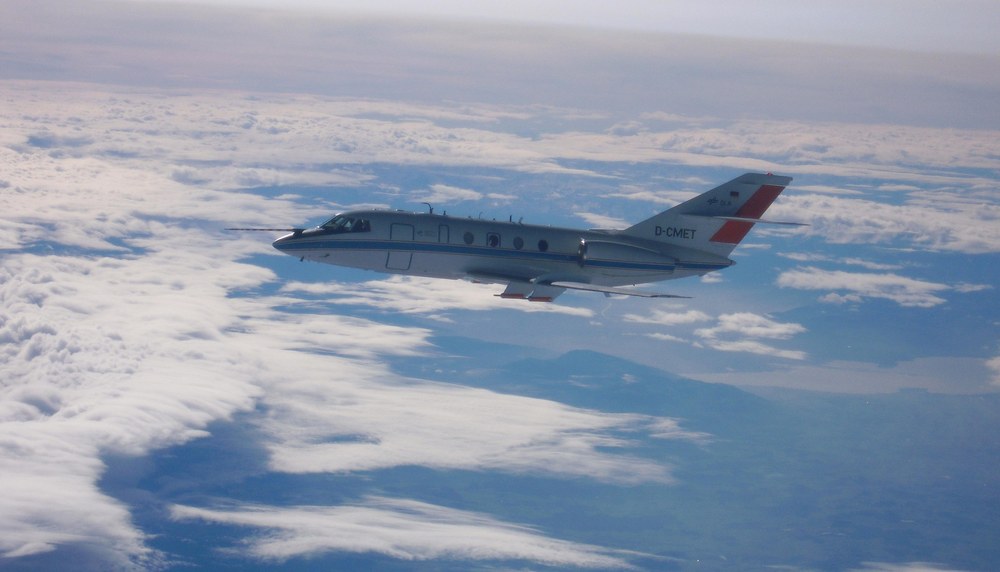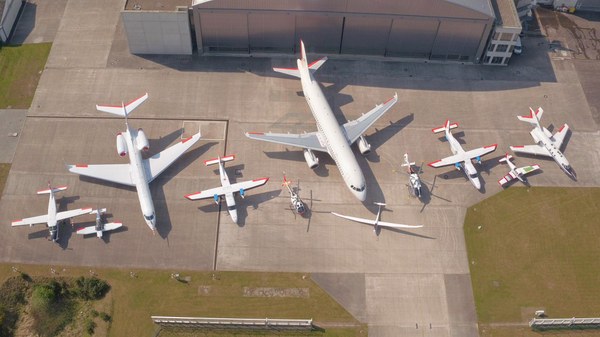DLR’s Flight Operations Facility is responsible for the deployment and utilisation of DLR’s fleet of highly-modified research aircraft.
Dassault Falcon 20E-5 - D-CMET



The Dassault Falcon 20E-5 (registration D-CMET) has been extensively modified for use in research by the German Aerospace Center (Deutsches Zentrum für Luft- und Raumfahrt; DLR). The DLR flight facility in Oberpfaffenhofen primarily uses the aircraft for atmospheric research for over 40 years. International research teams measure trace gases and aerosols directly from on board the aircraft, and they collect air samples for subsequent laboratory analysis. This twin-engine jet is based on a business aircraft produced by French company Dassault. It can fly at altitudes of up to 12 800 metres.
The research aircraft has been in use since 1976. Over this period, it has become one of the most important German and European airborne research platforms for observing the Earth and its atmosphere. In over 40 years of deployment in environmental and climate research, the aeroplane has acquired a leading position among European research aircraft. The Falcon 20E-5 therefore also plays an important role in the EUropean Fleet for Airborne Research (EUFAR), an initiative bringing together 28 leading European institutions and companies in the field of airborne research.
A flying laboratory for environmental and climate research
The Falcon 20E-5 can fly at higher altitudes than most airliners. It is extremely robust and versatile, so that measurements can even be performed in the proximity of thunderstorms or at a distance of just 30 metres behind the engines of an airliner. The Falcon's flight ceiling is sufficiently high for it to reach the lower stratosphere at mid-latitudes, which in recent years has become a focal point for research into ozone depletion.
Over the Norwegian mountains, for instance, measurements were performed on polar stratospheric clouds. During cold winters, these clouds significantly contribute to ozone depletion. Over the past few years, the Falcon 20E-5 has been one of DLR's most important research facilities for exploring the effects of aircraft emissions on the composition of the atmosphere. Its unique modifications and features make it a true multipurpose platform for research applications, and one which can be configured to meet individual needs.
Modifications
In its current form, the Falcon 20E-5 can accommodate a payload of up to 1 100 kilogram of scientific instruments. The instruments are mounted inside the cabin and underneath it, as well as under the wings.
Among other things, they include a flow measuring device, the so-called nose boom and antennas which can be mounted on the exterior of the aircraft.
In the top and the bottom of the fuselage, the Falcon has special optical windows for cameras and LIDAR systems (Light Detection And Ranging) used for atmospheric measurements. A LIDAR emits a laser pulse and then captures the signal as it is scattered back by the atmosphere. This allows the deduction of concentration profiles of water vapour, ozone or aerosol particles above or below the aircraft's flight altitude. For radar antennas, a side window can be replaced by a special disk.
The Falcon's avionics systems are continuously adapted to the meet the increasing requirements of scientific experimentation and of flight safety. This enables precision navigation and allows the unrestricted global deployment of the aircraft.
The following modifications and additions have been made to the Dassault Falcon 20E-5 (D-CMET) aircraft structure:
- Nose boom with integrated flow probe for measuring inflow velocity and direction of inflow
- A total of three special windows in the roof and the floor of the fuselage which can for instance be used for the deployment of LIDAR instruments for atmospheric measurements. The lower special windows can be protected against debris damage during take-off and landing by a roller door.
- New engines with additional power generators for supplying power to experiments (2x300 ampere at 28 volt)
- four small openings (with a diameter of eight centimetres) in the top of the fuselage
- four underwing hardpoints for carrying particle measurement systems (PMS)
- Central hardpoint on the bottom of the fuselage for carrying various measuring containers
- Side windows for infrared and radar antennas, so-called microwave measuring equipment
- Hardpoints on the lower aft section of the fuselage for carrying radiometers
Mission – Research focus
Over Iceland in the tracks of Aeolus
In 2019, scientists from the DLR Institute of Atmospheric Physics travelled over Iceland with D-CMET for the Aeolus mission. Aeolus is the name of the god of wind, borrowed from Greek mythology and given to a satellite that has been orbiting Earth since 2018 with the Atmospheric Laser Doppler Instrument (ALADIN) wind lidar on board. D-CMET, equipped with the first wind lidar, was used to compare data acquired by the aircraft with that from the satellite in the Aeolus Validation Through Airborne Lidars in Iceland (AVATARI) campaign. Iceland was chosen for the survey because of its ideal conditions. Changing high- and low-pressure areas ensure variable wind speeds, and a jet stream – a constantly shifting band of strong winds – is often within reach. The comparison is being used to validate the wind profiles generated by the satellite and to improve its evaluation algorithms in order to optimise models for weather forecasts.
Technical data
Falcon 20E-5 (registration D-CMET) | Data |
|---|---|
Length: | 17.2 metres (18 metres including nose boom) |
Height: | 5.32 metres |
Wingspan: | 16.3 metres |
Cabin length: | 5,5 metres |
Cabin width: | 1,7 metres |
Cabin height: | 1,62 metresr |
Seats: | 10 (For DLR research purposes: three seats for crew members and three scientists or engineers, depending on instrumentation) |
Unladen weight: | 7.53 tonnes |
Total weight: | maximum 13.2 tonnes |
Propulsion system: | two Garrett Turbojet TFE 731-5BR-2C |
Thrust: | 2x20 000 newton (no reverse thrust) |
Range: | approximately 3 700 kilometres |
Maximum altitude: | maximum 12.8 kilometres (42 000 feet) |
Speed: | maximum 917 kilometres per hour (Mach 0.865) |
Flight duration: | 5h30min (depending on payload) |
Fuel capacity: | 5007 litres (4.006 tonnes) |
Original use: | Business jet and military use |
DLR flight facility: | Oberpfaffenhofen |

